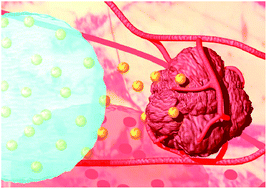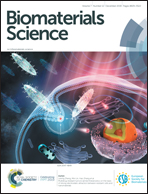Smart injectable biogels based on hyaluronic acid bioconjugates finely substituted with poly(β-amino ester urethane) for cancer therapy†
Abstract
Development of implantable material to control the release of chemotherapeutics in the body is a promising approach to control cancer cell proliferation; however, implantation requires surgical intervention. Herein, we propose the in situ formation of injectable biogels (IBGs) for the programmed delivery of potent chemotherapeutic drugs. IBGs are developed via cohesive molecular assembly of a polysaccharide-polymer network comprised of hyaluronic acid–poly(β-amino urethane). Biocompatible IBGs could be administered subcutaneously through a hypodermic needle in vivo to subsequently assemble into a microporous network. The hyaluronic acid-shielded network mimics the natural extracellular matrix, avoiding rapid degradation of IBGs, with a soft texture and adhesiveness facilitating integration with dermal tissues after subcutaneous implantation. The natural-mimicking architecture confers the IBG network controlled degradation and bioresorbable properties. Subcutaneous administration of IBGs controlled the delivery of a therapeutic agent in a spatio-temporal manner. Therapeutic agents delivered near the tumors in a sustained manner were effectively infiltrated into the thick solid tumors and provide a durable and enhanced anti-tumor response in the B16/OVA melanoma model in vivo. These results indicate that IBGs could be potential medical interventions for the treatment of cancers.



 Please wait while we load your content...
Please wait while we load your content...